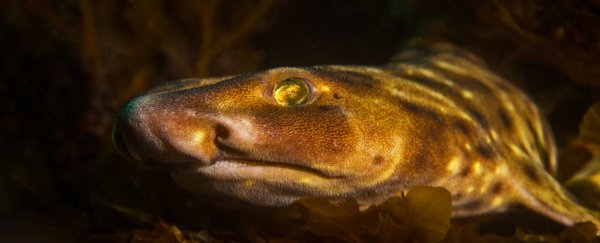It's been rumored that sharks don't sleep at all; the fact some sharks must stay on the move to facilitate their breathing has contributed to this idea.
A new study, however, finally confirms what anecdotal evidence and other research have long suggested – these animals do slumber, just as we do.
"We have provided the first physiological evidence of sleep in sharks," the team writes in their paper, led by ecophysiologist Michael Kelly from the University of Western Australia.
Two sleep phases are well known in birds and mammals, and even octopus – suggesting each stage plays an important role in our physiology, but little is known about this process in cold-blooded back-boned animals.
So the team investigated signs of sleep in the draughtsboard shark (Cephaloscyllium isabellum), which they'd previously discovered are nocturnal animals.
In a previous study, the researchers demonstrated it took greater electric stimulation for a shark to respond when the animal appeared to be resting – but they did not confirm this resting state was sleep.
Monitoring the sharks across 24 hours revealed their oxygen levels consistently decreased during these periods of restfulness, confirming those that extended beyond 5 minutes are indeed sleep.
"Not only do sleeping sharks have reduced responsiveness to stimulation, they also have lower metabolic rate," Kelly and team explains.
The sharks closed their eyes while asleep more commonly during the day – suggesting that eye closure is more likely associated with external factors like the presence of light, rather than the sleep state itself. During the night, 38 percent of sharks kept their eyes open, even while other indicators suggested they were sound asleep.
A better indicator of a sleeping shark is its posture, the team found. While snoozing, the draughtsboard sharks kept their bodies flat.
This species of shark is able to to remain motionless for extended periods of time, thanks to their buccal (face muscle) pumps which keep oxygenated water flowing across their gills while they're still.
Other species of sharks, such as the infamous great white (Carcharodon carcharias), don't have this pump and rely on forward swimming to push oxygenated water into their mouth and over their gills. This is known as ram-ventilation.
So if sleep turns out to be common across all sharks, how would the obligatory swimmers achieve it while still on the move?
Some researchers suspect it may have to do with the way these sharks control their swimming motion. A study in the 1970s found the mechanisms that oversee swimming movements in the small spiny dogfish shark (Squalus acanthias) are located in the animal's spinal cord and not the brain, so it may be possible for sharks to keep swimming while not being conscious.
There's still a lot about sleep in general that remains mysterious, so understanding how this process works in sharks could provide clues on how our own ability to sleep evolved. As the earliest group of jawed vertebrates, sharks represent an ancestral group to many animals known to rely on sleep for energy conservation and other important physiological processes.
"Future research should focus on other physiological indicators of sleep, such as changes in brain activity, for a more complete portrait of sleep in these vertebrates," the team concludes.
This research was published in Biology Letters (link not yet live at the time of publishing).
